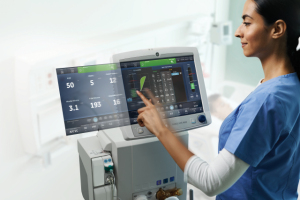by
Lauren Dubinsky, Senior Reporter | December 08, 2014

GE Healthcare's CARESCAPE R860
From the December 2014 issue of HealthCare Business News magazine
Just over ten thousand intensivists practice in the U.S. today, yet more than five million patients are admitted to the ICU every year, according to The Society of Critical Care Medicine. Now, with the growing elderly population in part due to medical advances that extend life expectancy, the disparity is only projected to increase.
When facilities are understaffed, it increases the likelihood of medication errors, patients being in for longer hospital stays with greater complication rates, and a list of other problems, according to a study conducted by the University of Calgary.
One solution gaining popularity in the battle against staff shortages is the concept of tele-ICUs. Tele-ICUs provide a command center made up of a team of intensivists and nurses who use audio and visual capabilities to deliver 24-hour care remotely. The team has access to patients’ vital signs, laboratory test results, radiologic images, notes and pharmacy, lab or radiology orders. They are also able to monitor patients using high-resolution cameras and microphones.
If a patient is showing signs of distress, the team can alert the bedside care team so they can intervene before the patient’s condition gets worse. In 2010, 41 command centers were deployed to cover 5,789 ICU beds in 249 hospitals, according to the New England Healthcare Institute and the Massachusetts Technology Collaborative.
Second set of eyes and ears
The origin of tele-ICUs started in the late 1990s, when two intensivists at The Johns Hopkins Hospital, Dr. Michael Breslow and Dr. Brian Rosenfeld, noticed the disparity between the number of ICU patients and intensivists who care for them.
They created a company called VISICU, Inc. and coined the term, eICU. The first system was installed in 2000, at Sentara Healthcare in Virginia.
In 2008, Philips Healthcare acquired the company for about $427 million and since then, the technology has come a long way. The original technology was relatively basic in that it only provided audio and video feeds and captured physiological monitoring data but Philips added more “smarts” to the command center.
“In essence, every ICU patient that is being monitored and supported through this telehealth center approach is caught before they get worse—that is basically the stitch in time saves nine approach,” said Manu Varma, vice president of strategy and hospital to home at Philips.
The centralized team consists of an intensivist, two nurses and a couple of other support staff who use Philips’ IntelliSpace eCareManager software to get the physiological data and EMR lab and medication data. The software then runs a range of predictive analytics to detect the acuity of the patient including whether ventilation compliance is where it needs to be and if the patient is going septic.
